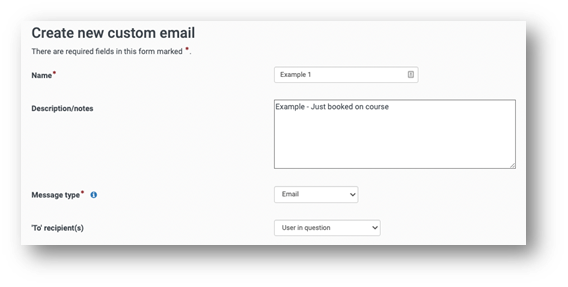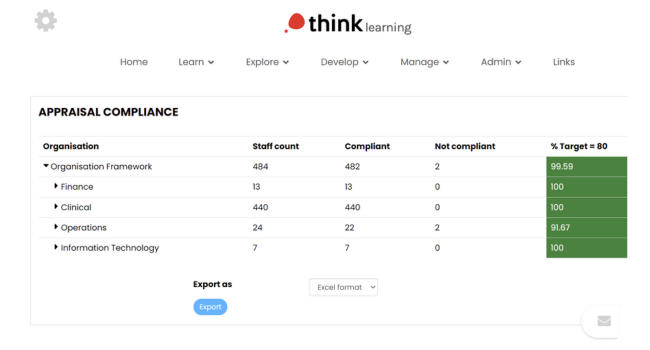
Having a healthcare LMS can ensure your clinical staff complete your training content and get more out of L&D.
The healthcare sector in the UK is a huge industry. In the NHS alone, there are over 1.2 million members of staff.
But despite its size and importance to the UK people and economy, it faces a number of challenges.
Post-COVID, healthcare has taken a hit. Now more than ever, there’s a staff shortage as we deal with an ageing population and high demand for care.
What role does L&D have in alleviating these issues?
In this blog, we’ll go through:
- What a healthcare LMS is
- Key L&D challenges in healthcare
- How a healthcare LMS can solve those challenges
Let’s get started.
What’s a healthcare LMS?
A healthcare LMS or learning management system is the platform used by health and social care services to train their staff.
Related: 10 must-have features of an LMS
The learning shared covers everything from:
- Compliance
- Technology
- Wellbeing
- Care techniques
And much more.
Related: Best LMS platforms to try
Key healthcare L&D challenges
There are several challenges that L&D professionals working in healthcare face when it comes to best supporting their clinical staff.
They can usually be summed up into the following:
- Compliance
- Time-poor staff
- Wellbeing
- Low digital skills
Let’s go through each in more detail.
Compliance
Compliance is a challenge for many sectors. But the healthcare sector has many statutory and mandatory regulations that all their staff need to be signed off for.
They are also regulated by the CQC which can see staff checked on procedures in real life, as opposed to just via training and documentation.
Breaching these regulations can result in hefty fines, so it’s important that health and social care settings are always hitting these standards.
While we know the importance of it, in the ever-stretched world of the NHS, healthcare compliance quickly falls to the bottom of the list of priorities. Patient care always comes first, and training often gets side-lined.
💡Pro Tip
Read our complete guide to compliance to see what challenges L&D face and how using the right tools can help address these roadblocks.
Complete guide to compliance [free pdf]
As such, L&D teams need to look at how they can easy the process.
Some good practices include:
- Putting your compliance learning front and centre on your LMS for ease of access
- Only testing staff on new legislation as opposed to repeating existing content
- Testing staff on their compliance knowledge and then prescribing training based on their results
Time-poor staff
While staff numbers have increased in some areas, there are more vacancies in the NHS than ever before.
This staff shortage highlights the huge stress that clinical staff are facing when it comes to workload.
As a result, they’re extremely time poor as they’re dealing with longer to-do lists than before and picking up the slack where departments are waiting to hire.
This exacerbates training being bottom of the list of priorities for clinical teams, despite them knowing the impact it can have on patient care, process efficiency and more.
Wellbeing
Leading off from this, it’s clear to see a correlation between a staff shortage and low wellbeing.
The 2022 NHS Annual staff survey reported that 45% of staff report feeling unwell as the result of work-related stress. Despite this dropping from 2021, this is an incredibly high number and 2020 and 2021 saw huge COVID impact.
As such, wellbeing has increasingly become an issue for L&D teams to address in the healthcare sector.
Low digital skills
When speaking to our customers, many of the LMS admins and support staff have stated the low digital skills they tend to see in clinical staff working in the NHS.
This is a huge challenge for learning and development teams as it creates a huge barrier for users in terms of just accessing the LMS.
Addressing this learning curve is the first step into getting teams onto the LMS and digesting content.
How can a healthcare LMS support your key challenges?
When building your LMS, you need to ensure that you’re creating a solution that will be used by your teams.
There’s no point investing in tools or products that won’t provide any training ROI.
So, you need to find a solution that’s going to be worth its weight.
To help, we’ve rounded up how Think Learning takes any healthcare LMS to the next level.
The standout features are:
- Appraisal and wellbeing check-ins
- Reminders and notifications
- Data linking
- Compliance
- ESR parsing
- Onboarding
- Supervision
- CPD and revalidation
- Support
Let’s go through these one by one.
Appraisal and wellbeing check-ins
Think isn’t just an LMS. It’s a full-service talent experience platform. Using Totara’s base code we can support customers with learning, performance, and engagement.
The performance arm of our solution allows you to automate your appraisal process.
Part of this includes health and wellbeing check-ins as standard, meaning that you can ensure your people are getting the support they need, when they need it most.
Reminders and notifications
One big issue that L&D struggles with is getting users to complete their training. When we’re talking about statutory and mandatory training, it’s vital that you get through to your users.
We have a handy little tool called ThinkNudge that allows you to send out reminders and notifications (by email and by text) to encourage course completion.

ESR parsing
When you’re providing L&D for thousands of users, it can be hard to keep track of job titles, ex-employees, and new starters.
A lot of LMS admins spend most of their time cleaning data.
We didn’t think this was right, so we worked on building strong data links between HR tools and authority networks to our LMS. This means that when, for example, someone changes a job role and it’s updated in ESR, it will automatically update in the LMS too.
And since you’ll be using audiences, that means the coursing they’re prescribed to will automatically change too if they’re moving departments or progressing up the ladder.
Compliance
Healthcare compliance is its own beast. But Think offers a range of ways to make it less click and tick.
You can automatically assign new users to courses based on their data, meaning less manual work for you.
You can also pull real-time reports on compliance where you can see rates by full organisation all the way down to an individual basis.

Onboarding
We can help pre-hire learners access the LMS and complete training, possibly using a personal email address initially before moving to a local IT account.
Related: Key benefits of good onboarding
Users on the site retain the same account as they move from pre-hire to employment, so their record of training stays with them automatically.
Using the CSTF interface, nationally recognised training data from previous employment will automatically be transferred from ESR into your Think LMS.
There it will update or create any new certifications so that your people data is up to date. This massively reduces data input and duplicated training.
Supervision
We have created three custom tools for supervision in the form for 2 different blocks:
- Management Supervision
- Professional Supervision
These blocks allow for recording of supervision sessions and are flexible enough to cover many situations:
- Internal Users
- External Users (invited by email)
- Group Supervision
The configuration available means that you can limit functions and access as needed to suit your organisation’s needs.
With these in place, you can:
- Record regular 1:1 session
- Target relevant users with requirement to undertake Supervision on 4- or 6-weekly basis
- Record sessions between staff/managers, and clinical mentors/supervisors
- Record group sessions recording
- Report on supervision
CPD and revalidation
Within the revalidation portfolio there are four main log types:
- CPD (participatory and non-participatory)
- Practice Hours
- Feedback
- Reflections
Users can view their target items/hours, their achieved items/hours, as well as be able to view and edit existing entries and add new entries.
They can also see a timeline (from their current revalidation date to their submission date, with a highlight on the current date).
Not only that but they can:
- confirm their insurance status
- confirm a declaration
- download submission templates
- download their uploaded logs and supporting attachments
- invite other users to be their Reflective Discussion Partner or Confirmer
Support and consultation
Last but not least is support. While we know we have great tech, we have even greater people.
We hire learning and development experts across our development, support and implementation teams. It means that our customers get access to industry knowledge and insight at all stages of the process.
Build your healthcare LMS with Think
Ready to start building your healthcare LMS? Or want to move over your existing content someplace new?
Book a demo with us to see how we can support you with a totally customised solution based on your personal challenges and issues.
Our team of experts will walk you through some of the tools mentioned above, as well as our tools that support better learner engagement, mentoring programmes and talent management.

